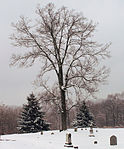Charles A. Miller House

The Charles A. Miller House is a historic residence in Cincinnati, Ohio, United States. Built in 1890 according to a design by Samuel Hannaford, it is a two-and-a-half story building constructed in the Gothic Revival style.: 5 A brick and limestone structure with a slate roof, its facade is dominated by courses of ashlar, plus battlements at the top,: 5 and a prominent portico at the entrance. The floor plan is that of a rectangle, two bays wide and four bays deep; the right portion of the building features a gable, while the battlements appear primarily on the left side. Structurally, the house is supported by a post and lintel construction, with the exterior courses of stones forming the lintels as well as horizontal bands around the building.
Excerpt from the Wikipedia article Charles A. Miller House (License: CC BY-SA 3.0, Authors, Images).Charles A. Miller House
Chase Avenue, Cincinnati Northside
Geographical coordinates (GPS) Address Nearby Places Show on map
Geographical coordinates (GPS)
| Latitude | Longitude |
|---|---|
| N 39.16451 ° | E -84.54836 ° |
Address
Chase Avenue 1817
45223 Cincinnati, Northside
Ohio, United States
Open on Google Maps









